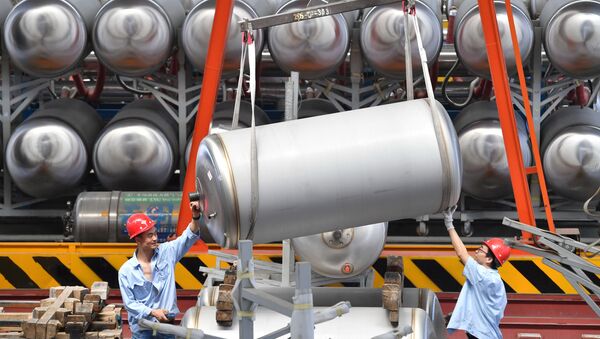CNPC Chairman Wang Yilin, in an exclusive interview, told Sputnik that global natural gas consumption may reach 4.7 trillion cubic metres by 2030, which is 800 billion more than in 2018 – mostly due to the growth of consumption in APR states. Which countries will become the main consumers and what competitors to natural gas exist? Read in Sputnik’s interview to find out.
Sputnik: What technologies and types of fuel can compete with natural gas?
Natural gas is expected to be least affected by the technological revolution in this area. In the field of transport, a large number of competitive energy sources have already appeared – steam diesel fuel, electric power, and hydrogen fuel cells – in this area the competition is very high. However, if LNG is used as fuel to provide power output, it can be used on a large scale for commercial purposes, and natural gas will have certain competitiveness in the field of transport”.
READ MORE: China May Regulate Energy Imports from US Amid Trade Row
Sputnik: Which countries of the Asia-Pacific region are potential leaders in gas consumption?
Wang Yilin: “We expect that by 2030 gas consumption will reach 4.7 trillion cubic metres. Compared to 2018, this is [an increase of] more than 800 billion [cubic metres]. 40 percent of the increase would be by APR states, almost 350 billion cubic metres. Gas consumption in China will reach 525 billion cubic metres; compared to 2018, growth will be 240 billion.
Speaking about other Asian countries, India is now experiencing robust economic growth; very soon it will enter a “golden era” of gas consumption. Pakistan, Thailand, Bangladesh, and other countries, their population is growing, representing a huge potential; gas consumption will surely increase in these countries in the near future”.
Wang Yilin: “Promoting a revolution in energy production and consumption, creating a clean low-carbon, and a safe and efficient energy system is the future direction of China’s energy sector. Natural gas is considered to be a relatively clean, low-carbon fossil fuel, and therefore plays an important role in the energy conversion process.
Russia is a neighbour of China; it is rich in natural gas and is the optimal partner of China in the cooperation of the gas industry’s development. According to the “Energy Strategy of Russia until 2035”, we take note of the fact that until this time, the volume of Russian gas exports to the Asia-Pacific region will make up 31 percent.
READ MORE: China Discovers 100-Billion-Cubic-Meter Natural Gas Reserve in Bohai Sea
Russia and China in the gas field have additional advantages, our cooperation has broad prospects. By the end of the year, the construction of the Russian-Chinese gas pipeline will be completed, and in the future, Russia will export gas up to 38 billion cubic metres. Moreover, the CNPC is participating in the Yamal LNG project. So in the near future, Russia will become the largest exporter of natural gas to China.
The views and opinions expressed by Wang Yilin are those of the speaker and do not necessarily reflect those of Sputnik.




